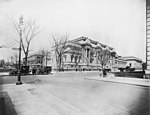George C. Parker

George C. Parker (* 1870 ; † 1936 ) was an American fraudster and forger . Because of his approach, he is still considered one of the most unabashed crooks in United States history. He made a living by “selling” New York attractions to unwary and naive tourists or immigrants . His favorite object was the impressive Brooklyn Bridge , which he sold about twice a week for years. He convinced his "clients" that they could make a fortune with the bridge tariff. The police had to intervene more than once when new "owners" tried to set up toll stations on the bridge .
Criminal career
In addition to the Brooklyn Bridge, Parker also offered the multi-purpose sports arena Madison Square Garden , the Metropolitan Museum of Art , the General Grant National Memorial (the national monument to the Commander in Chief of the US Army in the Civil War, Ulysses Simpson Grant , 1822–1885), and also the Statue of Liberty for sale.
Parker had many different sales methods. If he sold the Grant Memorial, he would pose as Grant's grandson. He even had his own office to make his real estate fraud look serious, and he was able to produce impressive documents - which he had forged himself - to prove that he was, in fact, the legal owner of the property for sale. He also successfully sold several shows and plays without having any ownership rights in them.
The Statue of Liberty (painting by Edward Moran )
Convictions
Parker was convicted of fraud three times. After his third conviction in late 1928, a Kings County judge named McLaughlin sentenced him to life in prison in Sing Sing , where Parker spent the last eight years of his life.
He was popular with the guards and inmates alike, whom he entertained with stories of his rip-offs.
public perception
Parker is widely recognized as one of the most successful scammers in United States history, as well as one of the most talented counterfeiters of all time. His "heroic deeds" found their way into popular culture , which led to sentences like " ... and if you believe that, I have a bridge to sell you " ( " ... and if you believe that, I can sell you a bridge") has, which means that someone is extremely naive and gullible.
In 1937, a year after Parker's death, the American comedy film Every Day's a Holiday appeared with Mae West in the lead role. The film takes up the theme of the rogue bridge sale and West plays the trickster Peaches O'Day, who used her charms in 1899 to get the Brooklyn Bridge for 200 US dollars from a naive man - with the receipt “ One bridge in good condition. ”(German:“ A bridge in good condition. ”) - for sale.
literature
- Carl Sifakis: Hoaxes and Scams: A Compendium of Deception, Ruses and Swindles. Facts on File, 1994, ISBN 978-0-8160-3026-2 .
- Luc Sante: Low Life: Lures and Snares of Old New York. Farrar, Straus & Giroux, 2003, ISBN 978-0-374-52899-7 .
- Todd Robbins: The Modern Con Man: How to Get Something for Nothing. Bloomsbury, 2008, ISBN 978-1-59691-453-7 .
- Susanna Lobez and James Morton: Kings Of Stings. Melbourne University Publishing, 2011 Kindle e-book.
Individual evidence
- ^ A b c Gabriel Cohen: For You, Half Price. In: The New York Times. November 27, 2005 (accessed August 30, 2012).
- ^ Brian Lane: Crime & Detection, DK Eyewitness. P. 19 (NY, DK 2005).
- ^ Gary Sturgess: We can show world how to build bridges. In: The Australian. March 26, 2007 (accessed August 30, 2012).
| personal data | |
|---|---|
| SURNAME | Parker, George C. |
| ALTERNATIVE NAMES | Parker, George |
| BRIEF DESCRIPTION | American fraudster and counterfeiter |
| DATE OF BIRTH | 1870 |
| DATE OF DEATH | 1936 |





